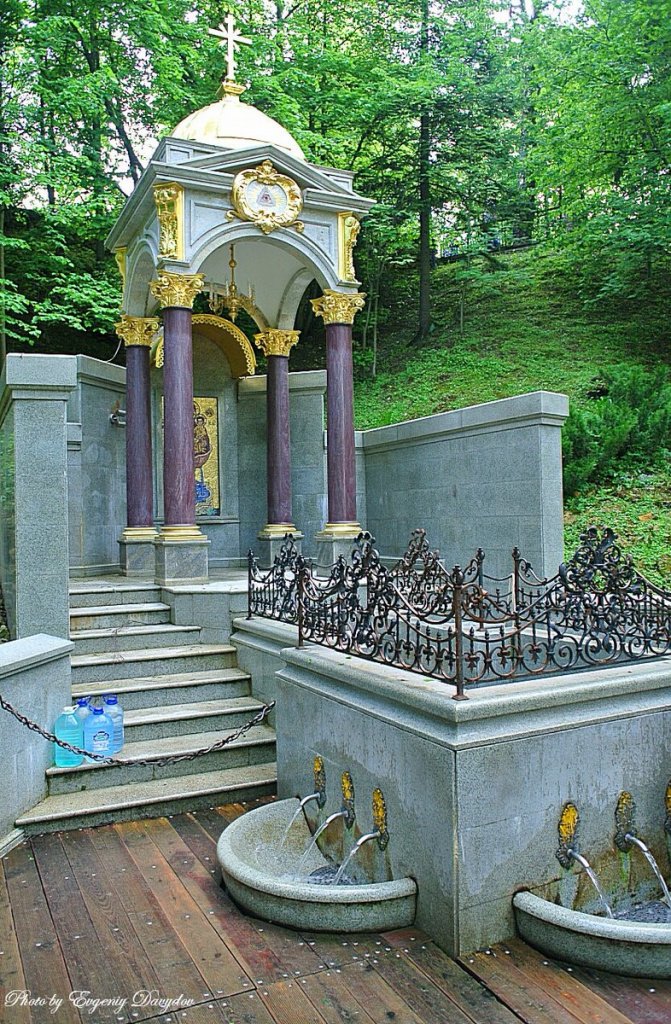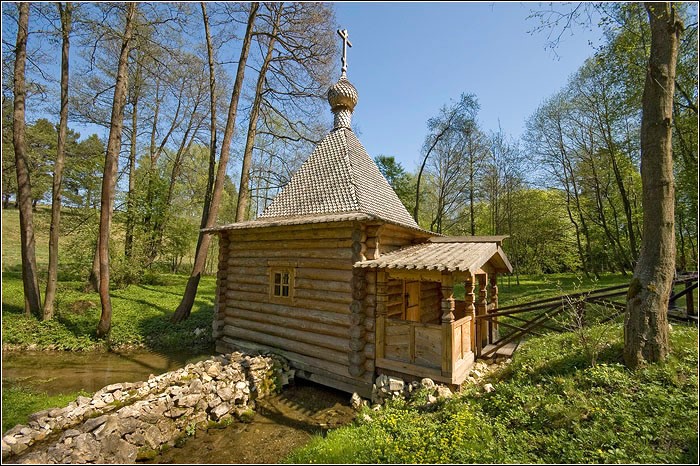
Yuri Kobyakov, a writer and local historian, member of the Public Chamber of the Chekhov Urban District and headman of the village of Peshkovo, told EcoTourism EXPERT about the tourism potential of the Lopasnya land.
- What is interesting about the Chekhov Urban District for study and tourism?
- The most beautiful part of the Lopasnya land (Chekhov Urban District), as this area has been called since ancient times because of the Lopasnya River, is the Voznesenskaya Davidova Pustyn (Ascension David’s Hermitage) founded in 1515. It’s located among the most beautiful and revered monasteries in the Moscow Region that has a rich history. After decades of ruin and desolation, the monastery was revived in 1995, restored to show its architectural splendor and was opened to all visitors. Not far away, there is a monastery courtyard in the ancient village of Talezh where a holy water spring is located in a beautiful place revered by local villagers for many centuries. A legend has it that the healing water of the holy spring was used by the first monks of the holy monastery headed by its founder, the Reverend David of Serpukhov, the Miracle Worker.

The village of Kryukovo is among the oldest ones in the Lopasnya land. People lived in this area back in the Bronze Age as evidenced by archaeological finds on the banks of the Lopasnya River. 500 meters away from the river, 18 burial mounds of the Vyatichi Slavs of the pre-Mongol period (12th-13th centuries) have been preserved in a forest area when their transition from pagan beliefs to Christianity was just beginning. There is the world-famous A. P. Chekhov Museum-Reserve in the village of Melikhovo. The great Russian writer lived and worked in a modest estate of the village.

- As far as I know, you also have a personal story connected with the writer.
- Right. In 1893, a country (zemsky) doctor cured a little girl, Masha Filippova living in the neighboring village of Malitsy. The doctor was A. P. Chekhov, and the little girl was my grandmother, who remembered him all her long life. So, if he had not cured and saved her at that time, my father, myself, my children, and my grandson wouldn’t be born.
Anton Pavlovich Chekhov did a lot for the residents of our Lopasnya land. There are a number of places in the Chekhov Urban District connected with his life and work, including the Museum of Letters in the town of Chekhov, a school built by the writer in the village of Novosyolki, a medical center in the village of Kryukovo, and others.
- What other discoveries await the tourists visiting the Chekhov District?
- Not many people know that these places are also connected with the life of Russian poet Alexander Pushkin’s family members and his descendants. Within the boundaries of the town of Chekhov is the Lopasnya-Zachatievskoye Museum-Estate, there is a manor house surrounded by an old park. The house belonged to the Vasilchikovs, a noble boyar family, since the 16th century. One of their relatives was Pyotr Lanskoy, who married Natalya Goncharova, Alexander Pushkin’s widow, in 1844. Both Natalya Goncharova and the descendants of the greatest Russian poet were frequent guests at the estate. And at the beginning of the last century, the estate belonged to her nieces. It was in this house in 1917 that a box with the greatest poet’s papers and a handwritten copy of History of Peter, an unfinished work by Alexander Pushkin were found by chance. After the revolution, a school was located in this house. But until the end of the 1920s, Pushkin’s family members continued to live in this house, in small rooms on the mezzanine floor; Grigory A. Pushkin, a grandson of the greatest poet, a former colonel in the Imperial Army and then a Red Army commander, who used to work as an accountant at the local district consumer union, his wife Yulia, a school teacher, and their five children. One of the children was Grigory G. Pushkin (1913 -1997), the last direct descendant of Alexander Pushkin in the male line living in Russia. Grigory Pushkin finished a 7-year school in the village of Lopasnya, and in 1930, he was in the first group of students of the Novobytovsky Technical School of Dairy Farming that was set up that year and was located on the area of the closed Voznesenskaya Davidova Pustyn.
In the yard of the nearby Church of St. Anne’s Conception (17th century), the tombstones of Alexander Pushkin’s descendants, including his eldest son Alexander A., have been preserved.
By the way, another historical fact associated with this estate is that in the fall of 1812, an Army’s guerilla detachment commanded by Colonel Prince Nikolay Kudashev was based near it; it successfully defeated the French troops in the Lopasnya land before the Battle of Tarutino. Now, we keep on working to establish the names of the soldiers and militiamen (former peasants) who died in that war; a chapel was built in their memory, monuments and memorial signs were also built.
- I suspect that the history of battles in these parts includes not only the events of the Patriotic War of 1812?
- Absolutely right. The Lopasnya land has repeatedly been in the combat zone in the past centuries. In the area of the village of Turovo, near the confluence of the Lopasnya River and the Oka River, there is the Senkin ford, the most convenient place for a river-crossing operation. In 1380, it was here that the Russian Army commanded by famous Dmitry Donskoy crossed the river on the way to the Kulikovo Field. Until the end of the 16th century, the Tsar’s Coastal Service was located in this area to protect the Oka River from crossing it by the troops of the Crimean Khanate and hordes of nomads.
In 1572, a large Nogai detachment, part of the Tatar-Turkish army heading for Moscow, broke through the Senkin ford with a fight. Near the village of Molodi, a fierce battle took place in the current Chekhov Urban District, the significance of which for the future of the Russian state is comparable to the Battles of Kulikovo and Borodino. The enemy was utterly defeated, after which large raids on our country’s land from the south ceased. Since 2009, in honor of this important event, a historical festival with a reconstruction of those heroic events, a costume party, a fair, workshops in ancient crafts, traditional Russian entertainments and amusements, etc. are held annually in July near the village of Molodi. There are other interesting facts related to the history of the Russian Army and directly connected with these places. For example, from the mid-17th century, by decree of Tsar Alexei Mikhailovich, large-scale mining of the best gun flint in Russia was launched on the banks of the Lopasnya River not far from the Voznesenskaya Davidova Pustyn. It was required for modernizing and equipping the Russian Army with modern rifles using a flintlock mechanism at that time. Even the royal charter on this matter, addressed personally to the abbot of the Voznesenskaya Davidova Pustyn, has been preserved. For over 200 years, the Russian Army was provided with weapons made using flints mined in the Lopasnya land.
- There are many interesting places in the Lopasnya land from the point of view of history, culture and nature. What other attractions would you recommend to visit? Are there any ideas and plans to develop a tourist cluster?
- There are indeed many interesting historical sites on the banks of the Lopasnya River. For example, near the village of Zavalipievo, there is a place where a fortified settlement of people of the ‘Dyakovo’ culture was located from the 8th century B.C. to the 6th century A.D. Stone tools related to the ‘Fatyanovo’ culture that existed 3 thousand years ago, as well as the traces of an ancient Slavic settlement, were discovered on a hill near the Starospasskaya Preobrazhenskaya Church (Old Church of the Transfiguration of the Saviour).
Downstream is the village of Khatun founded as a fortified settlement of the Vyatichi Slavs at the end of the 1st millennium A.D. For several centuries, the village was a center of the grand ducal, and then the royal Khatun Volost (district) that belonged personally to Moscow and Russian sovereigns. On the site of the ancient settlement on the high left bank of the Lopasnya River, a defensive ditch, 6 m wide and 3 m deep, has been partially preserved.
There is a unique estate complex in the village of Semyonovskoye on the bank of the Lopasnya that has a nice name - Otrada (Delight). This rich estate was founded in 1774 by Vladimir Grigorievich, one of the renowned brothers from the Orlovs family. In recent decades, the estate has gradually deteriorated, but even in this state, it attracts the attention of lovers of antiquity, painters, and local historians. A picturesque area and centuries-old forests and green meadows surround the estate.
I think it would be interesting to make a boat tourist route along the Lopasnya River, which can be promising for developing tourism in the area. The total length of such a route could reach 50 km - from the town of Chekhov to the confluence of the Lopasnya and the Oka rivers. While traveling along this tourist route, the travelers can stop and visit the main local attractions and settlements of historical and cultural significance. Developed tourist routes (bicycle trails in summer and sleigh ones in winter) connecting the most interesting places in the Lopasnya land could become popular with tourists.
Of course, a current underdeveloped infrastructure would hamper the growth of tourist flows to the Lopasnya land. A network of small hotels and campsites near the main attractions of the Lopasnya land is needed where tourists could stay overnight. Here is just an example. Near the Voznesenskaya Davidova Pustyn, a beautiful building of an old monastery ‘hospitium’ (Latin for ‘lodging for travelers’) has been preserved, which could be restored and become a magnificent hotel. The A. P. Chekhov Museum-Reserve in Melikhovo, the holy water spring in Talezh, and other interesting places in our region are just within a stone’s throw. There is not enough money for developing the hotel, although such a project could be attractive to potential investors.

Photos courtesy of Yuri Kobyakov.
